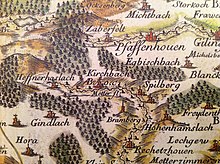Kirbachhof
|
Kirbachhof
City of Sachsenheim
Coordinates: 49 ° 1 ′ 5 ″ N , 8 ° 57 ′ 34 ″ E
|
|
|---|---|
| Height : | 281 m above sea level NN |
| Residents : | 21 (Sep 2011) |
| Incorporation : | 1973 |
| Postal code : | 74343 |
| Area code : | 07046 |
The hamlet of Kirbachhof belongs to the Ochsenbach district of the Sachsenheim community in the Ludwigsburg district of Baden-Württemberg .
geography
Kirbachhof is located a little north of the Kirbach between Ochsenbach and Häfnerhaslach in the Stromberg-Heuchelberg Nature Park .
history


The history of the foundation of the "Kirchbach" provost is somewhat unclear. While Abbot Tubingius von Blaubeuren attributed the founding to the Count Palatinate of Tübingen as a later burial place (he claims to have seen tombstones, urns and grave slabs in 1521), the foundation by Margrave Hermann von Baden and his wife Judith and Hummel von Lichtenberg to the Benedictine monastery Odenheim more likely in the diocese of Speyer (1158). A document mentions 1266 donations of goods in Kürnbach and Itzingen to the provost office by Adelheid von Liebenstein.
In 1442 the Kirbachhof provost in the Odenheim convent was sold to the Mariental convent in Frauenzimmern for 2,250 Rhenish guilders, because it has been in decline in recent years and is too remote from them . A year later, the Cistercian women moved their seat from women to the Kirbachhof , which became a monastery. As early as 1444, the monastery had to sell the town of Häfnerhaslach , located three kilometers to the west, to Count Ludwig von Württemberg for 1,000 Rhenish guilders , placing itself under Württemberg rule. As a result of mismanagement - over the years, large parts of the property had to be sold again and again - the monastery was dissolved in 1543. In 1556, Duke Christoph had the church building demolished because it was in disrepair. In the course of the Reformation from 1562, the now abandoned monastery buildings became the seat of the forestry office (the Stromberg forestry department was relocated from Sternenfels ) and the Württemberg estate.
In the 1660s, Duke Eberhard III. of Württemberg to the east of the Kirbachhof to create a 200 acre zoo with an oval lake for the ducal hunt and build a castle. The castle was demolished - presumably after a fire - under the aegis of Duke Carl Eugen in 1750.
The farm was owned by the state and after 1806 was under the administration of the Oberfinanzkammer. As part of an exchange, King Wilhelm I acquired the Kirbachhof as private property in 1820, which was administered by the Hofdomänenkammer. During the 19th century the domain covered 106 hectares. Since 1924, the domain area was leased in individual plots to citizens of the surrounding communities.
During the Second World War , on April 7, 1945, there was an artillery battle between French and withdrawing German troops in Kirbachhof. All agricultural buildings were destroyed, only the listed forestry office and the forester's house remained. In 1947, due to the influx of Catholic refugees , the first Catholic service since the Reformation was celebrated for the surrounding communities under Pastor Otto Langer. In the 1960s, two farms were partially relocated to the Kirbachhof.
On September 1, 2011, 21 people lived in five families in the Kirbachhof, it mainly houses farms.
Attractions
- Former manor house from 1837 (now forester's house) - a stately, plastered solid building with half-timbered gables and dwarf houses in the Swiss style .
- Kibannele , a sandstone statue of the ancient fertility goddess Cybele or the Roman hunting goddess Diana in the oval lake, dated around 1668 .
swell
- Main State Archives Stuttgart, holdings A 602, No. 8930 and N 7, No. 63
- Regional Council Stuttgart, Section 25 Monument Preservation, List of immovable architectural and art monuments in Baden-Württemberg, status 09/2006
- City archive of the city of Sachsenheim
literature
- The state of Baden-Württemberg. Official description by districts and communities (in eight volumes). Edited by the Baden-Württemberg State Archives Department; Volume III: Region Stuttgart - Regionalverband Mittlerer Neckar, Stuttgart, 1978. ISBN 3-17-004758-2 .
- Franz Quarthal: The Benedictine monasteries in Baden-Wuerttemberg, Germania Benedictina Volume V . Augsburg 1975
- Ochsenbach wine village. Landscape, people, history. Edited by the city of Sachsenheim. Sachsenheim 1990
Individual evidence
- ^ Domain tenants: 1810–1819 Friedrich and Jakob Greb; 1819–1824 Philipp Schaßberger, Großingersheim; 1824–1864 Karl Stefan Schaßberger, Hohenhaslach; 1864–1891 Gottlieb Schaßberger; 1891–1901 Christian Reiniger, Bietigheim; 1901–1904 Gustav and Wilhelm Hehr, Steinbachhof; 1904–1909 Emil Koppenhöfer, Stuttgart; 1909–1924 Agricultural District Association Brackenheim (sub-tenants: Friedrich Hack, Meimsheim, 1909–1911; Karl Steinmetz, Derdingen, 1911–1919).


